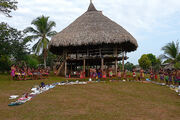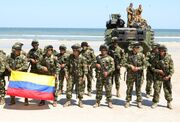| Languages | Spanish (official) Kuna, Northern Emberá (co-official) Woun Meu, English (minority) |
| Capital | Ukupseni |
| President | Juana López |
| Status | 1991-1999: Protectorate 1999-present: Autonomous region |
| Area | 21,715 km2 |
| Population | 30,000 |
| Currency | Colombian peso (COL$) |
| Subdivision of |
Not to be confused with Darien, an autonomous settlement in the former U.S. state of Georgia that is allied with Cuba.
Darién - more properly, Darién-Kuna-Emberá - is an autonomous region of Colombia. It encompasses the wild rain forest region that used to be the eastern end of Panama.
Background[]
The Province of Darién was formed in 1925. That same year, a revolution broke out among the Kuna people, who protested the suppression of their culture by the Panamanian government, specifially the police. Panama relented and granted self-rule to the Kuna by creating the autonomous comarca of Kuna Yala, administered by its own General Congress. Kuna Yala did not include all Kuna communities; several smaller ones in Darién remained without self-government. In 1983, a revolt broke out among the region's other major indigenous group, the Emberá people. By September, plans were underway to create an autonomous comarca similar to Kuna Yala, comprising forty Emberá and Wounaan villages; however, the events of September 26, and their disastrous effects on the country,ended such plans.
Aftermath[]

The women of an Emberá village display some of their crafts. Refugees would widely copy indegenous architecture, in both the camps and the permanent villages that replaced them.
The swampy Darién rain forest is one of the most inhospitable places in Central America - indeed, it is so impassable that the Pan-American Highway could not be built through it, the only gap in the highway's Alaska-to-Chile route. Nevertheless, refugees fleeing violence in the Canal region attempted to pass through it and reach Colombia. Few survived the journey. Far more refugees attempted to eke out a living on the forest edge, but the disorganized camps that emerged offered chances of survival little better than the forest. Meanwhile, they suffered from the violence gripping central Panama as American army troops and elements of the Panamanian National Guard competed for control over the region between the Darién and the canal.
The Kuna and Emberá societies, still very traditional, attempted to draw back into themselves and rely on their ancient cultural bonds to weather the crsis. But the humanitarian, ecological, and security pressures were too great. The tide of refugees pushed many Kuna and Emberá eastward into Colombia.
Cooperation with Colombia[]
Panamanian refugees were a great concern to the Colombian government in late 1983 and early 1984. Engaged in crucial negotiations with various guerrilla groups, many of which used the Darién as a hideaway, Colombia could little afford to risk further destabilization. Camps were established in the vicinity of Turbo to accommodate those who had survived the journey through Darién. In the meantime, a small complement of Colombian troops were sailed to Kuna Yala to help maintain security. It was reasoned that stability in eastern Panama would prevent the refugee situation from becoming a crisis.
Kuna Yala authorities and Colombian troops attempted to bring order to the string of camps in eastern Panama. They were unsuccessful, and certainly not for lack of effort. Refugees often would not obey dictates from authorities whom they dismissed as tribes people or foreigners. Resources were scare, violence was endemic, disease rife, and sanitation non-existent. And meanwhile, clashes with armed Panamanian groups continued. Peace came to Colombia by 1985, so the country was able to send more troops and supplies into Darién. However, conditions in the camps and throughout the Darién region remained horrifying.
For a number of reasons, the situation began to stabilize by 1987-88. For one, Colombian aid was finally making a difference, and conditions began to improve in some of the camps. By then, Colombia had established several permanent bases for its soldiers in Darién. This allowed them to keep hostile soldiers and guerrillas out of the camp area, and it made the humanitarian project more effective and efficient. Additionally, the staggering death rates of the previous years reduced the population and took some pressure off the region. Large numbers of American troops had departed Panama for the Virgin Islands, while a few tried to make for Australia after receiving news of the "Gathering Order". The biggest factor, however, was that the Colombian army facilitated the immigration of many refugees into Colombia, where they could expect more food and better prospects than in the fractured remains of Panama.
Kuna and Emberá tribal structures were shaken but intact. The Kuna Yala government had been Colombia's go-to organization in the region and therefore was not lacking in money or muscle. In 1988, the Emberá created a local government for themselves modelled on the Kuna. It relied far more on traditional tribal authorities than the planned Panamanian comarca. It also excluded the tiny Wounaan community, who organized themselves by 1990. Other organs of local authority, however, had long collapsed by the end of the 1980s.
The creation of Darién-Kuna-Emberá[]

Colombian soldiers shortly after capturing gurerrilla positions near La Palma. Fighting in Darién continued on some level throughout the 1990s and beyond.
The greatest hindrance on the refugee communities was the absence of any authority to organize them. Colombian, Kuna, and refugee leaders hammered out a plan for the Darién Regional Authority in the summer of 1988. The Authority was intended to replace the collapsed governments of Panama and of Darién Province, and to handle such issues as sanitation, land use, and restoring local pre-Doomsday settlements. Security and defense were still to be provided by Colombia, and the Kuna General Congress was given a supervisory role as well, including a limited veto power over Regional Authority decisions.
The territory under the control of the Darién Regional Authority was never clearly specified. No indigenous communities were included, confirming the de facto independence that the Kuna, and other indigenous communities outside Kuna Yala, had exercised since Doomsday.
By the early 1990s, the regional government was effective enough that local people wished to take it over themselves. The Latino population resented Kuna supervision, and they wished to clarify the regional government's vague relationship with Colombia. The different indigenous groups themselves needed reliable, regular means to arbitrate disputes among themselves and with the Latinos, both native and refugee.
Colombia responded with concerted efforts to coordinate the region. In 1991 Colombian authorities met with local leaders, both indigenous and Latino, and created a new structure for governing the entire Darién. The state that emerged was given the cumbersome name of Darién-Kuna-Emberá and would function as a Colombian protectorate. The new state, which would quickly be called "Dakuném" by almot everybody, replaced the old Regional Administration and was placed above the indigenous governments, which would remain autonomous but have to follow the laws of the region.
The regional capital was located in Ukupseni, a Kuna island town, for reasons of convenience - Ukupseni and the adjacent shore land had been the center of Colombian activity in the Dakuném area since 1984, and Colombia wanted continuity. The decision was supposed to be temporary, but eighteen years later, the capital has not been relocated.
Autonomous Region of Colombia[]

Panama today, showing the Darién region (dark green) and its semiautonomous tribal comarcas.
Colombia's Congress voted to formally annex Dakuném, making it Colombian territory, in 1998. The final decision was to be decided in a referendum, but most inhabitants saw annexation as inevitable, the vote a mere confirmation of the status quo. Before the new autonomous region was officially created - indeed, even before its boundaries were surveyed - local politicians were campaigning to represent it in Congress. The annexation took place on January 31, 1999.
Shortly after voting to annex the Darién, Congress passed another act claiming all of the territory of Panama for Colombia. Panama had been a Colombian province until 1903 when it became an independent nation. The old province had been called "Istmo", but the act only used Panama's modern name. However, Colombia was unable to make good on its claim outside Darién. An act of Congress created the "East Panama District" late in 1999 as a first step toward pacifying the region east of the Canal. The military expedition in 2000 ended in failure. During the 2000s Colombia tried several times to colonize the District, but was not able to extend its control past the defensive line of bases along Dakuném's border.
At the same time, progress was made in the Canal Zone. Colombia had been working with Venezuela and Ecuador to reopen the Panama Canal. It was officially declared operational on May 1, 2000, and was opened to commercial traffic in 2003. The CZ did not belong directly to Colombia, however, but to a multinational team under the new South American Confederation. In 2008, as one of its first major acts, the League of Nations confirmed South American control. Many people from the Darién Autonomous Region have played a crucial role in rebuilding the Canal Zone, work that remains incomplete.
Darién today[]

President López
For the last decade, Darién-Kuna-Emberá has on the whole been a peaceful part of Colombia. Strategically, Colombian control has helped the government maintain peace throughout the country, since rebel groups now have more difficulty using the rain forest as a refuge. The strong role played by Dakuném's indigenous people has inspired groups elsewhere in Colombia to pursue greater autonomy, occasionally violently, but usually not. The sheer wildness of the region ensures that it will always maintain a life of its own sparate from the rest of Colombia. It remains underdeveloped and poor, which is a source of tension with the other provinces of the country. Public health remains the single most pressing issue in the region, with malaria and dysentary widespread.

Dakuném's president is entitled to wear a distinct presidential sash, a symbol of the region's autonomy.
As an autonomous region, Dakuném elects a president and assembly that have considerable authority over local issues. The region's politics are dominated by local parties, and elections often break down along ethnic lines, with Latinos and indigenous people competing for power. The current president, moderate reformist Juana López, is Latina. She is a native of Darién, even though a majority of the region's current non-indigenous people are refugees from elsewhere in Panama. López is the first woman to hold the top executive position in Darién.
The basic design of the flag of Darién-Kuna-Emberá dates to 1992. Green represents the rain forest, white the hope for peace and a pure environment. The white band is wider to suggest the "Darién gap", the famous name for the rain forest area. The seal was added to the flag's hoist upon annexation in 1999. It is of a simple black-on-white design, showing the region's name and an emergent tree to symbolize rebirth and high aspirations. The four stars were originally supposed to represent Dakuném's four ethnic groups, but the symbolism was soon changed to represent "security, diversity, ecology, and unity". The seal is omitted from some versions of the flag.
See also[]
| ||||||||||||||
| ||||||||||||||||||||||


